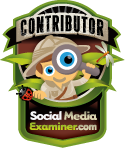
One of the most underrated qualities in business is understanding the customer. On many levels this is significant, but especially for marketers that want to attract the attention of an audience.
Assuming you have the technical capabilities, there is one a simple test for determining if your marketing is likely to be attractive to your audience.
Which one of the following describes your marketing?
- Look at Me.
- Look at Me Looking at You.
Running a better business these days is a shift from the traditional marketing mindset. Customers today are already looking – that’s what the Internet does so well.
When they find your business, customers want to quickly know you understand them – or they are gone.
How can you communicate this? Here are three suggested practices.
#1 – Be Humble
This hardly seems like a business quality, but it may well be one of the most important today. True leaders earn the attention of their communities not by showing off, but by being humble enough to learn.
Being humble is a quality that shifts your attention from your business to that of the customer – and it’s an important one. Even if you do understand your customers well, they may not yet know that. This is why it’s essential to listen, observe, and patiently earn their trust.
It’s tempting to assume you have what he customer wants, even if you do. Taking a little extra time to be considerate of them will create the alignment that is is necessary for building a successful relationship.
There why being humble is one of the ten core values of Zappos – it works.
#2 – Speak the Language of Your Customers
My friend Marty Grunder owns a successful landscape company. Recently he published a newsletter in which he responded to the suggestion that he stop referring to landscape companies as landscapers, and instead use the more professional terms, such as landscape contractor.
Years ago I was struggling with the optimization of my landscape company website when I discovered the magic of speaking the language of the customer. The words your customers use are more than information; they are part of their DNA.
The right words resonate, instantly making a connection by communicating a mutual understanding.
More important is that good SEO requires using the words and phrases that your customers are using. When I surveyed my landscape customers back then they overwhelmingly responded that landscaper was the term they would use to describe companies like ours.

Try it. Survey your customers. You may be surprised at what you learn.
There are many free tools for accomplishing this, such as Survey Monkey, Wufoo, or my preference, the Google Docs form builder.
While there are many online keyword search tools, such as Google Adwords, nothing works as well for small businesses in local communities as feedback from real customers.
#3 – Ask Questions
Questions are amazingly powerful for creating alignment with your customers. First, asking questions shows you care.
Just asking the right questions shows you have a solid understanding of your customers. What you learn after that only serves to better refine your knowledge of that customer base.
Traditional sales and marketing was transaction oriented. However, the better selling and marketing methods today are inherently focused on the relationship. A key component of a successful relationship selling process is asking good questions that help the business learn what they don’t know.
Be humble. Learn what you don’t know. Ask questions.
Customers today hope they are buying into a relationship with a business, not just executing a transaction. They want to know you will support them long after the first sale. It’s an expectation.
Remember the days of 100% Guaranteed? That’s history.
“Of course it’s guaranteed, that’s why we bought from you.” That’s what your customers are thinking.
Naturally, just your being here is a good indication that you understand that.
Over to you now. Leave a comment to share your thoughts.
About the Author: Jeff Korhan, MBA, is the author of Built-In Social: Essential Social Marketing Practices for Every Small Business and host of This Old New Business podcast.
He helps mainstream businesses adapt their traditional growth practices to a digital world. Connect with Jeff on LinkedIn, Twitter, Facebook, and Google+





Blog Commenting Guidelines
Commenting is what makes a blog article a living and breathing document. When you make insightful, witty, or thought-provoking comments, you encourage a dialogue that adds value for the entire community of the blog – for today and into the future when new readers happen along. Our Blog Commenting Guidelines 1. Be Yourself 2. Be […]
Read the full article